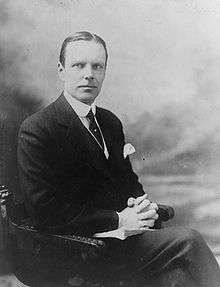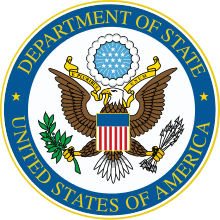William Phillips (diplomat)
| William Phillips | |
|---|---|
 | |
| 2nd Assistant Secretary of State | |
|
In office January 24, 1917 – March 25, 1920 | |
| President | Woodrow Wilson |
| Preceded by | John E. Osborne |
| Succeeded by | Fred Morris Dearing |
| Under Secretary of State | |
|
In office April 26, 1922 – April 11, 1924 | |
| President | Warren G. Harding |
| Preceded by | Henry P. Fletcher |
| Succeeded by | Joseph C. Grew |
| United States Ambassador to Belgium | |
|
In office February 29, 1924 – March 1, 1927 | |
| President | Calvin Coolidge |
| Preceded by | Henry P. Fletcher |
| Succeeded by | Hugh S. Gibson |
| United States Ambassador to Canada | |
|
In office February 17, 1927 – December 14, 1929 | |
| President | Herbert Hoover |
| Succeeded by | Hanford MacNider |
| Under Secretary of State | |
|
In office March 6, 1933 – August 23, 1936 | |
| President | Franklin D. Roosevelt |
| Preceded by | William R. Castle, Jr. |
| Succeeded by | Sumner Welles |
| United States Ambassador to Italy | |
|
In office August 4, 1936 – October 6, 1941 | |
| President | Franklin D. Roosevelt |
| Preceded by | Breckinridge Long |
| Succeeded by | George Wadsworth |
| Personal details | |
| Born |
May 30, 1878 Beverly, Massachusetts |
| Died | February 23, 1968 (aged 89) |
| Alma mater |
Harvard College; Harvard Law School |
William Phillips (May 30, 1878 – February 23, 1968) was a career United States diplomat who served twice as an Under Secretary of State.
Life
Phillips was born in Beverly, Massachusetts. He attended Harvard College in 1900 and graduated from Harvard Law School in 1903. His first political job was working as a secretary in London to Joseph Hodges Choate, the United States Ambassador to the United Kingdom. Choate was a friend of Phillips' family and also from Massachusetts.
Phillips subsequently went to work for the Ambassador to China in Beijing. In 1908, while in China, he was assigned to set up the State Department's Division of Far Eastern Affairs and was made its first chief. In 1909 he returned to work in London.
In 1917, he was appointed as Assistant Secretary of State under President Woodrow Wilson and remained in that position until 1920, when he was made the Minister Plenipotentiary to Netherlands and Luxembourg (in residence in the Netherlands).[1]
From 1922 to 1924, he served as Under Secretary of State. In 1924, he was appointed as Ambassador to Belgium, where he remained until 1927, when he became the first Minister to Canada, until 1929.[1]
He served as Under Secretary of State again from 1933 to 1936.[1]
In 1936, he was appointed as the Ambassador to Italy (which was then led by Benito Mussolini), in the immediate aftermath of that country's invasion of Ethiopia. He resigned on October 6, 1941. The following year, he was made chief of the United States Office of Strategic Services in London.[1]
In October 1942, Phillips was appointed as a personal representative of Franklin D. Roosevelt, serving in India.[2] (The United States would not have an official Mission there until the country's Independence in 1947.) Phillips was said to be extremely unpopular with the British due to his pro-independence views. In 1943, he was made a Special Advisor on European political matters to then- General Dwight D. Eisenhower, with the rank of ambassador.[1]
Phillips retired officially in 1944 but returned briefly to diplomatic life in 1945 when he was made a special assistant to Secretary of State Edward R. Stettinius, Jr. In 1946, he served on the Anglo-American Committee on Palestine, opposing the British plan for partitioning the country. In 1947, he was unsuccessful in mediating a border dispute between Siam and French Indo-China.[1]
His son, Christopher H. Phillips, served as United States Ambassador to Brunei from 1989 to 1991.[3]
References
- 1 2 3 4 5 6 "William Phillips, Former Ambassador, Dies at 89.". New York Times. New York, N.Y.; pg. 27, 1 pgs. February 24, 1968. Retrieved 8 March 2013.
- ↑ Phillips to India, Time Magazine, 1942-12-21.
- ↑ Negri, Gloria (February 11, 2008). "Christopher H. Phillips, 87, state senator, ambassador". The Boston Globe.
External links
| Wikimedia Commons has media related to William Phillips (diplomat). |
"William Phillips (1878-1968)". State Department. Retrieved 8 March 2013.
